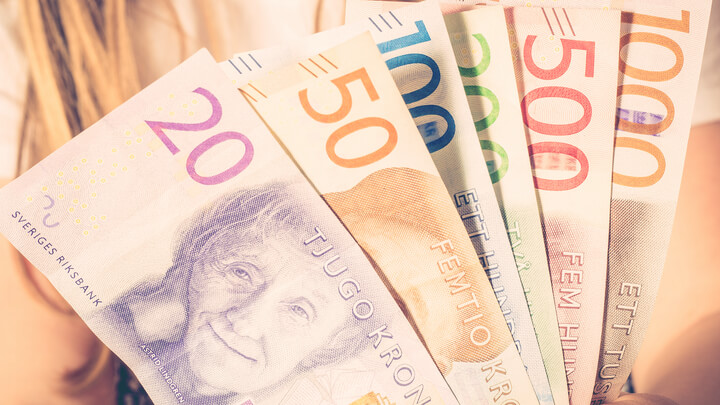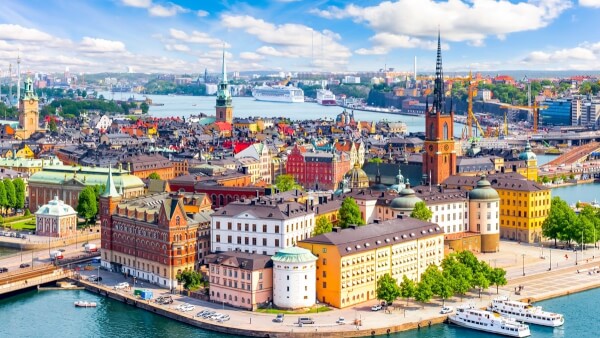Is it better to use cash or card in Sweden?
Should you pay with cash or card in Sweden? A handy guide including cash etiquette, Swedish ATMs and using your UK card.

Sweden is a beautiful northern country not only known for its peaceful nature, but for its out-of the box ideas.
Take, for example, the fact that Sweden was the first country with its own telephone number. Their tourist board created it for their Call-a-Swede campaign - where curious outsiders could call and get connected with a random Swede somewhere in Sweden who had signed up to be a phone ambassador for their country.
No worries, though, if you missed out on calling their phone number, then you can still probably talk to a random Swede in person. In order to do that, though, you’ll need some cash in your pocket as you navigate through the country.
This is your quick guide to currency and banking in Sweden to get you on your way.
Sweden’s currency is the Krona, often translated as ‘Crown’ in English.
It's worth noting, however, that while the currencies of Denmark and Norway are also known as Crowns, each country has a separate currency system. If you're travelling in the region you’ll have to exchange cash at each destination.
| --- | --- |
| Krona Symbols & Names | SEK, Kr, ‘Crown’ |
| 1 SEK | Each Swedish Krona is technically divided into 100 öre, but in practise the tiny öre coins have been phased out and any items priced in öre are rounded up to the nearest Krona. |
| SEK coins | Krona coins are available in 1, 5 and 10 Krona denominations. |
| SEK banknotes | Common banknotes are the 20, 50, 100, 200 and 500 Krona. There are also larger 1000 SEK notes in circulation but they aren’t commonly used and may not be universally accepted. |
Similarly, other currencies such as the Euro aren’t commonly accepted in Sweden outside of the seriously touristy areas. If you try to spend Euros, you’re likely to be hit by a poor exchange rate - and U.S. dollars aren’t generally accepted anywhere.
Many Swedes prefer to use plastic over cash - some cafes and kiosks in Stockholm even refuse cash payments and accept cards only. So you're not likely to need a great deal of hard currency for your trip if you prefer to rely on credit and debit cards.
However, having a bit of cash on hand is a comfort, and can be useful in an emergency.
You'll find plenty of reputable exchange offices when you get to Sweden - if you need currency when you get there, you can exchange a small amount at the airport. However, it’s good to take note that the exchange rates at airports and hotels are generally poorer than in other parts of town where there’s more competition.
It’s usually best to exchange only a small amount, and then seek a better deal elsewhere. Otherwise, consider using an ATM to withdraw SEK directly at a reasonable rate. (More on that, later.)
Before you choose a currency exchange service, make sure you understand the mid market rate for the currency you want to swap. This is the only real exchange rate, with all tourist rates somehow derived from this magic number (by formulae decided by the exchange service themselves).
You can access the constantly fluctuating number by checking it on an online currency converter. Then, once you know the mid-market rate, you can compare it with the exchange rates offered to tourists. Find out whether a deal is actually fair.
Wherever you decide to exchange your cash, watch out for fees snuck into poor exchange rates. Even if a service claims ‘Zero Commission’, they nearly always add in their profit to the disadvantageous exchange rate they offer.
If you do have cash on hand and need to exchange it, make sure you bring banknotes that aren’t already damaged. Many businesses will refuse to exchange your cash if it’s unclean or in bad condition.
Traveller’s Cheques can be exchanged in Sweden - try the Forex Bank exchange service. However, the rates given are not very great.
While some travellers still prefer this route for security reasons, you should take into account the poor exchange rates. Many prefer to ditch the paper cheques these days, and, instead, rely on their plastic.
Sweden is recognised as one of the most cashless societies in the world. All major cards are widely accepted, with retailers, hotels, and even taxis and ticket kiosks taking cards. Occasionally, you’ll come across restrictions on American Express, as with elsewhere in Europe. If this is your main card provider, then it’s worth asking in advance of making a payment.
Whatever your preferred card, it’s still a good idea to let your bank know you're travelling in case their anti-fraud software blocks your account. Sweden, depending on where you’re from, can be pretty expensive. It’s best not to be caught without any way to pay for your trip.
The other thing to watch out for if you rely on card is something called Dynamic Currency Conversion (DCC). Essentially, DCC is billed as a ‘service’ in which you can choose to see the amount listed in your home currency rather than the local.
While it may feel more comfortable and familiar to see figures in your own currency, it’s also, unfortunately, not a great idea. DCC means authorizing the foreign bank to make the conversion for you - normally at a much poorer exchange rate than your home bank would have, and often this even comes with extra fees.
So if you see the option come up on an ATM or your waiter or store assistant asks if you want to be charged in your home currency - say no. Choose to pay in the local currency (SEK) instead.
ATMs are fairly plentiful in Sweden and are often called ‘Bankomats’. You should spot them easily as most of them are blue. Try one of the locator tools below to find a convenient ATM in your network.
Visa ATM locator
MasterCard ATM locator
Amex ATM locator
DCC (see the description in the previous section) is sometimes offered when you withdraw money from a foreign ATM. Unfortunately, though it may look harmless, it’s not a good idea. Always select to be charged in local (SEK) currency, not your home currency, when withdrawing money to ensure you get the best exchange rates and fairest deals.
Sweden has a sophisticated banking system that extends to many other Scandinavian and Baltic areas of Europe. The ‘big four’ listed below are the largest and most common banks you’ll will find there.
If you're travelling to Sweden it is a good idea to ask your home bank if they work with any specific banks in Sweden. If they have partnerships in Sweden then you might be able to access some services for a reduced fees, such as using certain ATMs for fee free cash withdrawal.
Alternatively, for simple access to your money abroad - and an even better deal with transparent fees - use Wise.
If you have a bank account in Sweden, or know someone who does, you can transfer money between bank accounts in different countries using the real mid-market exchange rate. It's a quick and convenient way to get your Krona cash, with no hidden fees.
*Please see terms of use and product availability for your region or visit Wise fees and pricing for the most up to date pricing and fee information.
This publication is provided for general information purposes and does not constitute legal, tax or other professional advice from Wise Payments Limited or its subsidiaries and its affiliates, and it is not intended as a substitute for obtaining advice from a financial advisor or any other professional.
We make no representations, warranties or guarantees, whether expressed or implied, that the content in the publication is accurate, complete or up to date.

Should you pay with cash or card in Sweden? A handy guide including cash etiquette, Swedish ATMs and using your UK card.

Discover how to claim your VAT refund in Sweden with our comprehensive guide. Learn about Sweden’s VAT refund process for getting your refund.

Sweden is certainly cool - both in terms of the climate, and the city vibe. Hit Stockholm or Gothenburg for your cultural fix, sail, kayak or feast on...

Stockholm is the wonderfully cultural capital city of Sweden. If you’re planning a trip to Stockholm, you’ll be wanting to convert some cash to enjoy what the...